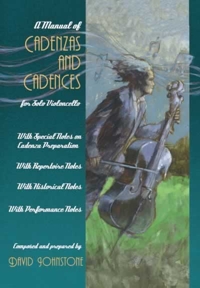
How does one play a Cadenza? Certainly a most pertinent question ... Many years ago many an innocent asked ‘Can you teach jazz or is it in-born to be developed by instinct by each individual?’ Today Jazz has been introduced as a main-stream subject in many of the important conservatoires of the world. The same could well be said of cadenzas. It can be left to instinct but it is usually far safer by ‘guidance’. The present author of ‘Cadenzas and Cadences’ has had the opportunity, and the privilege, of performing nearly all the standard ‘great’ concertos with orchestras, and has generally thoroughly enjoyed those special Cadenza moments. One does simply the very best that one can, comforted by the realization that very well delivered phrases give an enormous inner satisfaction, but also with the conviction that less than 100% delivered phrases might not seem perfect to us, the ‘executors’, but to virtually the entire general public are certainly most convincing. However, when this same author has occasionally sat on an exam panel in a conservatoire, or on an audition panel for an orchestral job, he frequently has found instrumentalists who have played decently well during the entire movement arrive at the point of the cadenza and suddenly (rather blatantly) present their up-to-now not portrayed ‘nerves’ which unfortunately then proceeds to rather limit their cadenza ‘delivery’. Why cannot this be a moment to ‘enjoy’, a moment to gladly ‘exhibit’ regardless of the technical and musical level that one has attained at that moment? Perhaps students have tackled difficult cadenzas before they are really ready - after all a Concerto is not by nature an easy type of piece, it is a ‘concertante’ work, and the cadenza to the movement in question simply cannot be easier than the material of that movement for it would not make sense nor serve its purpose. However there is also a strong feeling that the uneasiness relating with cadenza playing also evolves from a decided lack of material - meaning that there are often very few choices available in the playing and planning of cadenzas.
We have to learn what makes a particular cadenza ‘tick’ and how it might be more convincing. Cadenzas need above all to be spontaneous - as if they seem improvised to the listeners’ ears even though they well may have been practised for many, many hours at home. When the notes are in place, one has to coax out the musical intents – especially the planning of the volume levels and the give and take of the speed. As in previous centuries some form of improvisation is beneficial and helps to gain even more understanding – all the cadenzas/cadences in the present publication are only a base from which to work from. The composer is obviously very grateful for when a mention of ‘his’ cadenzas is made in performances, so they may become available knowledge for other performers, but an even more important thing is that they may serve for future developments, rather like many Scottish celtic melodies which have subtly changed their shape and decoration over the last 250 years or so sometimes resulting in little resembling the original effort! We have to remember that composing, improvising, arranging and general experimenting always played a large part in cadenza playing through the centuries. Many virtuosi had from the outset their cadenzas carefully planned note-for-note; others used their rough pre-conceived guides as a model and from this base enjoyed the ‘relative’ security of an easy improvisation; whilst occasionally a few even dared to leave the whole thing to a wild moment of spontaneity. As generation by generation has passed the innovative and spontaneous nature of cadenzas have continually lessened and lessened to the extent that it is now extremely rare for anyone to try to regularly include elements of improvisation in the twenty-first century. Unfortunately, the choice offered is all too often sparsely limited. Sometimes the student is expected to play the cadenza in the printed edition when there is an offering included, especially if his/her teacher has not performed the work. The possibility of another one often does not even come into question. Sometimes the teacher has indeed played the work, and even knows it intimately, frequently resulting in the student being passed on their own cadenzas. But, incredibly, serious attempts at producing volumes of well-organized cadenzas for the Violoncello could be counted almost on one hand throughout history. This to the present composer-cellist seems so strange when these moments form such an important part of each concerto that contains one. What is more, finding suitable cadenzas that are eminently playable by good students when they initially study the work are even more of a scarcity, and virtually non-existent in a collectable set or volume whose objective is to be of optimum service for classical, romantic and twentieth-century styles. So in a nutshell that is what this volume tries to do - well playable cadenzas and cadences that sound impressive to the listener - therefore suitable for auditions, exams, and above all for public performances with orchestra.
David Johnstone